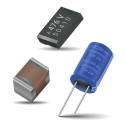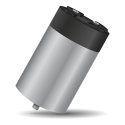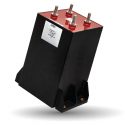Surface Mount Capacitors for DC-DC Converter Applications Written By: Naotaka Hata Abstract: Tantalum, polymer, ceramic, film, and aluminum capacitors each offer a different set of operating and performance characteristics. Choosing the proper capacitor when designing DC-DC converters requires a careful understanding of these differences. High voltage front-end connections to the power source typically rely on aluminum capacitors, while intermediate step-down voltages often look towards the tantalum and ceramic families to take advantage of volumetric efficiency. The final load decoupling and bypass capacitors are generally found in the ceramic and film families. Surface mount (SMD) capacitors can be constructed using several different technologies to achieve a range of voltage tolerance, bulk capacitance, and parasitic device characteristics. As shown in Figure 1,
Film Technology
Controlled Self-Healing of Power Film Capacitors Written By: Kevin Cho Abstract: In high voltage, high energy applications such as electric trains and solar power grids, the safety and reliability of capacitors are paramount. Catastrophic failures and associated explosions or fires are unacceptable. Just as importantly, service lifetime and predictability for optimizing up-time are critical to the product’s success. Film capacitors with controlled self-healing are the ideal solution to these challenges and can be obtained in various sizes and technical specifications. This whitepaper discusses the distinctions between aluminum electrolytic and metal film capacitors before considering some distinct advantages of film capacitors and the self-healing properties of metallized film capacitors.
Predicting Metal Film Capacitor Lifetime Using Thermal Simulation Written By: Youssef Laamimat Abstract: In high-power applications like electric vehicles (EVs), customized metal film capacitors are often required to meet energy demands in a specific form factor. These capacitors exhibit a strong temperature dependence of their bulk capacitance over time, which directly limits their total service life. To maximize lifetime while minimizing space requirements, it is important to include accurate thermal simulation as part of the design process to ensure optimized and evenly distributed heat generation.
Leading-Edge AVX Technology in Film Capacitors Written By: Masato Nishikiori Abstract: With the advent of plastics in the middle of the 20th century, the film capacitor was introduced as a technological leap over traditional paper-based designs. Film capacitors use a thin plastic film as the dielectric that separates multiple metal electrodes. The electrodes are either deposited directly on the film (metallization) or are built from separate metal foils. The plastic metal sandwich is wound on a bobbin, and a terminal contact layer is deposited to connect all of the individual capacitor layers in parallel effectively.
Evolution of Power Capacitors for Electric Vehicles Written By: Gilles Terzulli Abstract: Electric vehicles are in widespread use. Hybrid cars are now a common sight on our roads as people look to find more environmentally-friendly forms of personal transport, and there are many other commercial and public electric vehicles, such as trains, trams, buses and industrial trucks and equipment in everyday use. The electronic systems and components that have enabled the realisation of such a wide variety of electric vehicles have all experienced a major evolution, including the DC link power capacitor. The purpose of capacitors in electric vehicles is to prevent ripple currents from reaching back to the power source, and to smooth out DC bus voltage variations. Capacitors
Film Technology To Replace Electrolytic Technology Written By: Gilles Terzulli | Billy W. Peace Abstract: Since 1980, great improvements have been made on DC filter capacitors using a combination of metallized plastic films and different segmentations of the metallization on those film dielectrics. Volume and weight have been reduced by a factor of 3 or 4 over the last years. Now film manufacturers have developed thinner films and have improved segmentation techniques used on the metallization which has helped immensely in the improvement of such capacitors. Using non-gas impregnated designs, the voltage ranges between 600 VDC and 1200 VDC can be more economically covered by film capacitors rather than electrolytic. Depending on the application, over 1200 VDC, vegetable oil-filled versions
Film Technology To Replace Electrolytic Technology in Wind Power Applications Written By: Gilles Terzulli Abstract: Aluminium electrolytic capacitors present serious challenges for the designer of high voltage power systems required in the very latest wind energy applications. In contrast, film technology offers significantly improved life expectancy, environmental performance and power handling capability.







